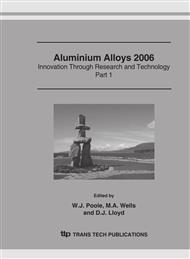p.985
p.991
p.997
p.1005
p.1011
p.1017
p.1023
p.1029
p.1035
Application of the Three-Dimensional Damage Percolation Model and X-Ray Tomography for Damage Evolution Prediction in Aluminium Alloys
Abstract:
A three-dimensional damage percolation model, which captures the effect of microstructural heterogeneity on damage evolution, has been developed to model damage initiation and propagation in materials containing second phase particles. It considers the three phenomena preceding ductile rupture of the material: void nucleation, growth, and coalescence. Threedimensional X-ray tomography is used to obtain measured three-dimensional second phase particle distributions in aluminum alloy sheet. Material damage evolution is studied within a tensile test simulation and compared to measured damage from an in situ tensile test utilizing X-ray tomography. Experimental and simulation results for material damage initiation and evolution are in good agreement.
Info:
Periodical:
Pages:
1011-1016
Citation:
Online since:
July 2006
Authors:
Keywords:
Price:
Сopyright:
© 2006 Trans Tech Publications Ltd. All Rights Reserved
Share:
Citation:


